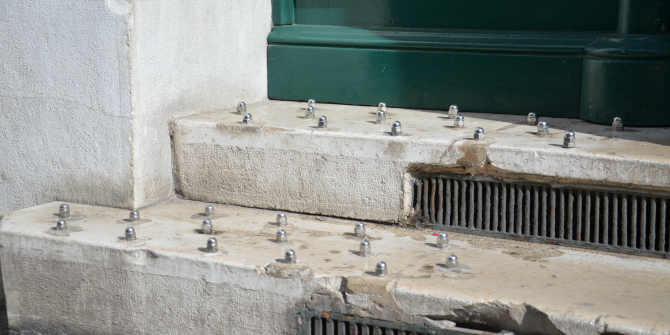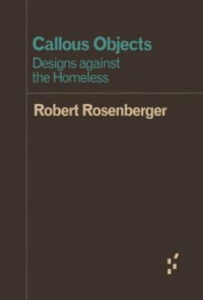In Callous Objects: Designs Against the Homeless, Robert Rosenberger explores the growth of ‘hostile architecture’ and reflects on what it suggests about society’s attitudes towards the homelesss as well as our relationship with contemporary design. This short, vivid and novel book serves as a timely reminder that our public spaces are not experienced equally, writes Jon Dean.
Callous Objects: Designs Against the Homeless. Robert Rosenberger. University of Minnesota Press. 2017.
Last year in England, it was estimated that 4,800 people slept rough. This was 15 per cent higher than in 2016, and more than 60 per cent higher than in 2010 when the Conservative-led Coalition government came to power. Given that one of the understated successes of the Labour government had been the dramatic reduction in homelessness since the millennium, current homelessness statistics, and the increased visibility of roofless populations in towns and cities across the UK, is perhaps one of the clearest markers of the poor state of British society and the health of our public morality. While the current government have taken some initial steps to tackle the problem, when the relatively tiny amount of money assigned by the Homelessness Reduction Act (around £71m) is spread thinly among Local Authorities it will do little to address the root causes of homelessness: namely, benefits sanctions, poorly-paid and precarious work and the mental health crisis.
Society’s disdain for the homeless is also revealed by the growth of what is known as hostile architecture, most viscerally represented by the small metal spikes set into the marble or concrete under cover around buildings, particularly office blocks and new luxury flats. These spikes are put there to deter homeless people (specifically the roofless and unhoused) from lying there, to either beg for money or to sleep. Robert Rosenberger’s new book, Callous Objects, seeks to document the growth of such hostile architecture and how it works, as well as to unpick what it suggests both about our relationship to modern design and to homelessness.
Rosenberger, a philosopher of technology who writes about the mundane everyday objects of urban life, contributes Callous Objects as part of a series of short interventions seeking to turn blogs and conference papers into longer, more considered pieces of work, where authors are encouraged to think out loud and draw ideas together. Very reasonably priced and easy to read, this book compiles examples of simple technologies that have been designed to deter rough sleepers.
 Image Credit: ‘Hostile architecture’ in Marseille, France (DC CC BY SA 3.0)
Image Credit: ‘Hostile architecture’ in Marseille, France (DC CC BY SA 3.0)
Rosenberger is particularly interested in benches: a low-tech device that has multiple public uses, some of which (sitting, stretching during a run) are considered good, and others of which (sleeping) are considered bad. Rosenberger documents how this simple design – a straight flat piece of wood or metal – has frequently been adapted to make it impossible to lie down or sleep on. Think of bus shelter benches that are thin and tilted, designed for perching rather than sitting, or benches with big solid arm rests in between designated seats. Whereas once a bus shelter would offer an unhoused person plausible deniability – ‘I wasn’t sleeping, I was merely waiting for a bus’ – now it is the designers and city planners who have the deniability – ‘It’s not that we don’t care about the homeless, we just think the bench is better with arms to separate sitting people.’
Readers will find a host of examples from across the world of such design – from Amsterdam, to Tokyo, to the London Underground and cities across the US and Canada. Rosenberger has photographed and documented the precise ways in which each technology plays a mediating role in the experience of urban life, and serves to make the lives of the roofless more difficult.
This analysis is extended from spikes and benches to how public bins work, with bin design reflecting their fraught social status. Rosenberger shows how designers around the world have made it much harder for people to use bins for anything else but disposing of litter. Such restrictive design modifications – where non-solid sides mean they can’t be used by graffiti artists, and locks and tight lids mean those seeking to look through the rubbish cannot access them – demonstrate how designers have thought about what is and isn’t ‘acceptable’ usage.
The book discusses this through Latourian Actor Network Theory, and taps into ontological debates around the multistability of everyday artefacts. This theory is carried lightly through the book, which will appeal both to social researchers in associated fields and the generally morally-concerned. Rosenberger also documents several ways in which people, particularly artists and activists, are fighting back against such public artefacts. The satirical ‘Pay & Sit’ bench by Fabian Brunsig (2008), where metal spikes protruding through a bench retract when a coin is deposited into a slot, is both a deeply chilling insight into a neoliberal future for public services and spaces, but also serves to demonstrate the wide range of critical responses to such defensive and hostile architecture.
This short, vivid and novel book serves as a timely reminder that our public spaces are not experienced equally – hostile architecture seeks to make some of our fellow citizens unwelcome in public spaces. All technologies have multiple uses; social and political forces will always try to limit choice when it comes to these, and we have to pay attention to how this happens in the most mundane ways.
- This review originally appeared at the LSE Review of Books.
Please read our comments policy before commenting.
Note: This article gives the views of the authors, and not the position of USAPP– American Politics and Policy, nor of the London School of Economics.
Shortened URL for this post: http://bit.ly/2prd7xe
About the reviewer
Jon Dean – Sheffield Hallam University
Jon Dean is a lecturer in politics and sociology at Sheffield Hallam University. He received his PhD from the University of Kent, focusing on the role of social class in youth volunteering. He writes about charity, inequality and creative qualitative research methods. Read more reviews by Jon Dean.


 Find this book:
Find this book: 



